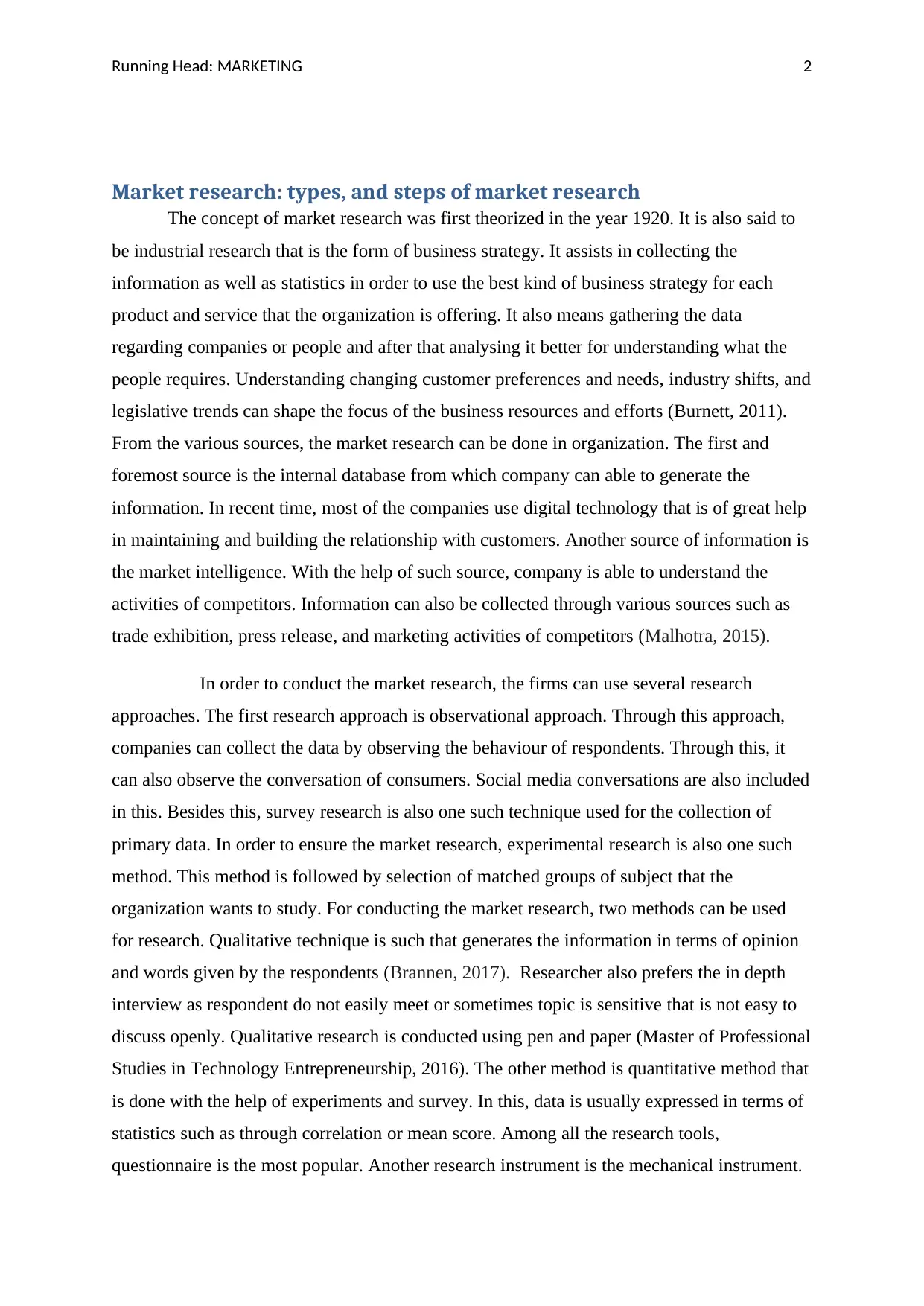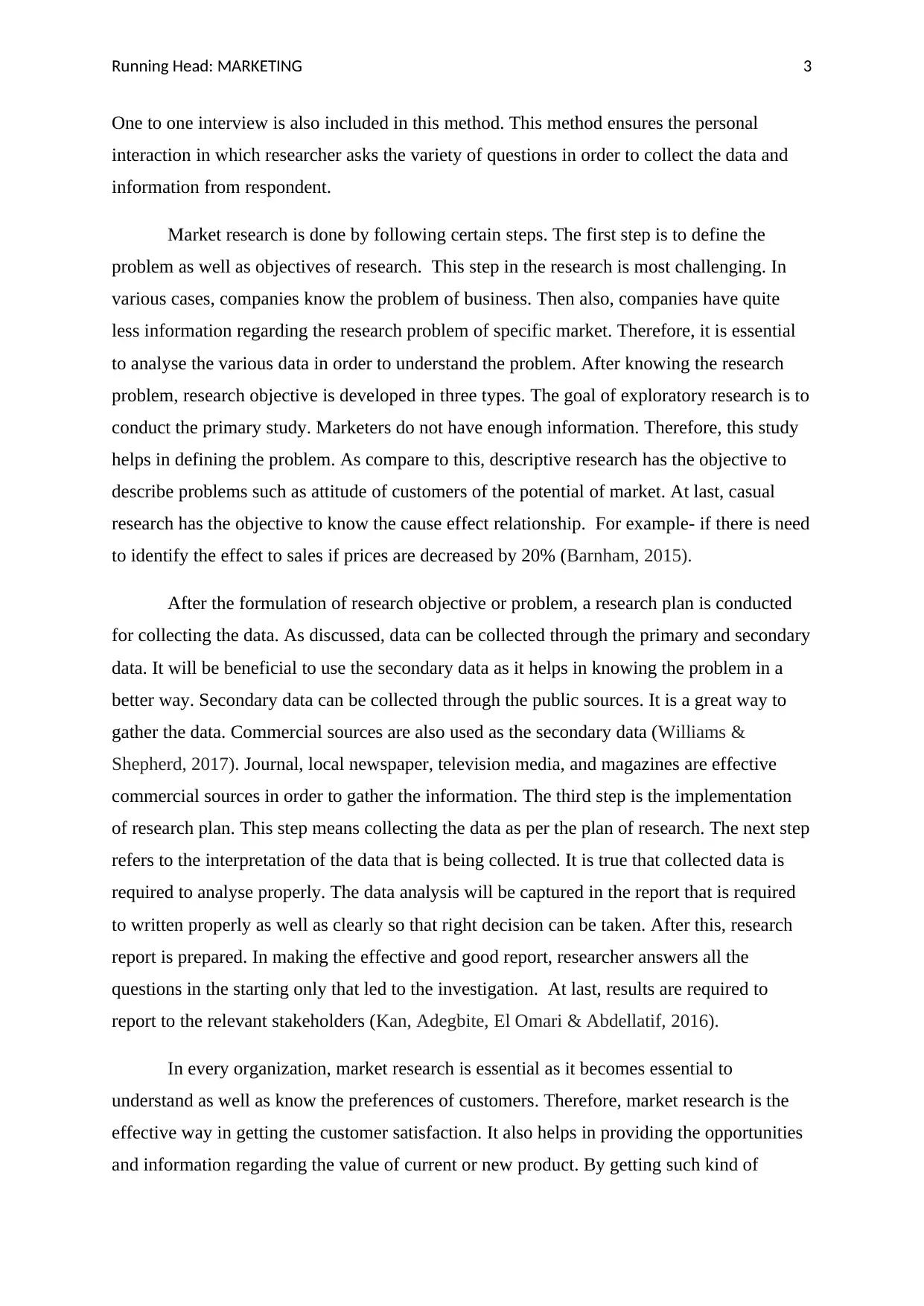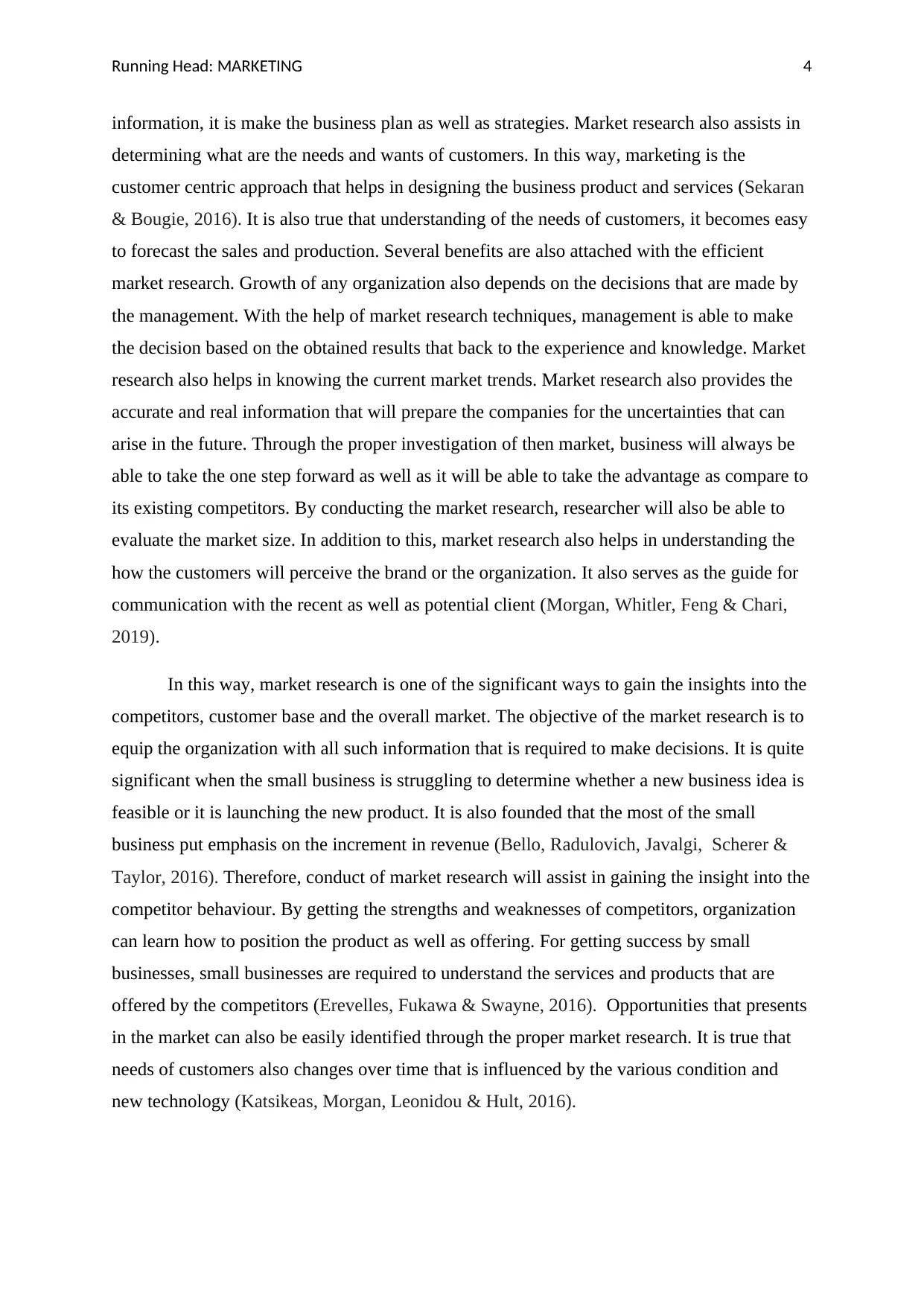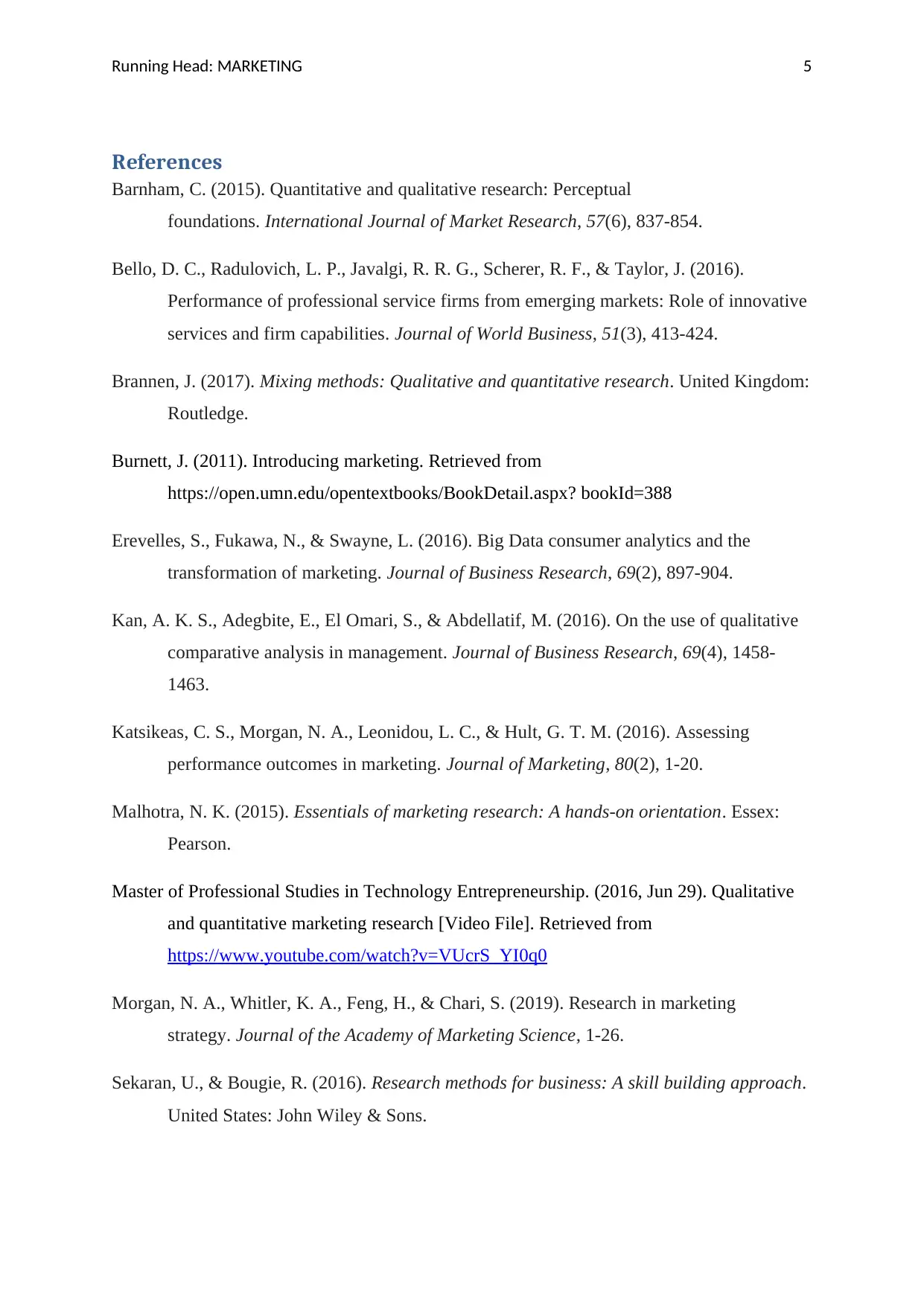Market Research: Types, Steps, and its Role in Business Strategy
VerifiedAdded on 2023/01/13
|6
|1963
|61
Essay
AI Summary
This essay provides a detailed overview of market research, starting with its definition and historical context, emphasizing its role in gathering information and statistics to inform business strategies. It identifies internal databases and market intelligence as key sources of information, alongside observational, survey, and experimental research approaches. The essay differentiates between qualitative and quantitative research methods, highlighting the use of questionnaires and interviews. It outlines the essential steps in conducting market research, including defining the problem and objectives, developing a research plan, implementing the plan, interpreting the data, and reporting the findings to stakeholders. The importance of market research in understanding customer preferences, identifying opportunities, and supporting decision-making is underscored, noting its benefits for small businesses in gaining insights into competitor behavior and market trends. The document concludes by stating that conducting market research assists in understanding competitor behavior, understanding the services and products offered by the competitors and identifying opportunities that presents in the market.

Running Head: MARKETING 1
Marketing
Marketing
Paraphrase This Document
Need a fresh take? Get an instant paraphrase of this document with our AI Paraphraser

Running Head: MARKETING 2
Market research: types, and steps of market research
The concept of market research was first theorized in the year 1920. It is also said to
be industrial research that is the form of business strategy. It assists in collecting the
information as well as statistics in order to use the best kind of business strategy for each
product and service that the organization is offering. It also means gathering the data
regarding companies or people and after that analysing it better for understanding what the
people requires. Understanding changing customer preferences and needs, industry shifts, and
legislative trends can shape the focus of the business resources and efforts (Burnett, 2011).
From the various sources, the market research can be done in organization. The first and
foremost source is the internal database from which company can able to generate the
information. In recent time, most of the companies use digital technology that is of great help
in maintaining and building the relationship with customers. Another source of information is
the market intelligence. With the help of such source, company is able to understand the
activities of competitors. Information can also be collected through various sources such as
trade exhibition, press release, and marketing activities of competitors (Malhotra, 2015).
In order to conduct the market research, the firms can use several research
approaches. The first research approach is observational approach. Through this approach,
companies can collect the data by observing the behaviour of respondents. Through this, it
can also observe the conversation of consumers. Social media conversations are also included
in this. Besides this, survey research is also one such technique used for the collection of
primary data. In order to ensure the market research, experimental research is also one such
method. This method is followed by selection of matched groups of subject that the
organization wants to study. For conducting the market research, two methods can be used
for research. Qualitative technique is such that generates the information in terms of opinion
and words given by the respondents (Brannen, 2017). Researcher also prefers the in depth
interview as respondent do not easily meet or sometimes topic is sensitive that is not easy to
discuss openly. Qualitative research is conducted using pen and paper (Master of Professional
Studies in Technology Entrepreneurship, 2016). The other method is quantitative method that
is done with the help of experiments and survey. In this, data is usually expressed in terms of
statistics such as through correlation or mean score. Among all the research tools,
questionnaire is the most popular. Another research instrument is the mechanical instrument.
Market research: types, and steps of market research
The concept of market research was first theorized in the year 1920. It is also said to
be industrial research that is the form of business strategy. It assists in collecting the
information as well as statistics in order to use the best kind of business strategy for each
product and service that the organization is offering. It also means gathering the data
regarding companies or people and after that analysing it better for understanding what the
people requires. Understanding changing customer preferences and needs, industry shifts, and
legislative trends can shape the focus of the business resources and efforts (Burnett, 2011).
From the various sources, the market research can be done in organization. The first and
foremost source is the internal database from which company can able to generate the
information. In recent time, most of the companies use digital technology that is of great help
in maintaining and building the relationship with customers. Another source of information is
the market intelligence. With the help of such source, company is able to understand the
activities of competitors. Information can also be collected through various sources such as
trade exhibition, press release, and marketing activities of competitors (Malhotra, 2015).
In order to conduct the market research, the firms can use several research
approaches. The first research approach is observational approach. Through this approach,
companies can collect the data by observing the behaviour of respondents. Through this, it
can also observe the conversation of consumers. Social media conversations are also included
in this. Besides this, survey research is also one such technique used for the collection of
primary data. In order to ensure the market research, experimental research is also one such
method. This method is followed by selection of matched groups of subject that the
organization wants to study. For conducting the market research, two methods can be used
for research. Qualitative technique is such that generates the information in terms of opinion
and words given by the respondents (Brannen, 2017). Researcher also prefers the in depth
interview as respondent do not easily meet or sometimes topic is sensitive that is not easy to
discuss openly. Qualitative research is conducted using pen and paper (Master of Professional
Studies in Technology Entrepreneurship, 2016). The other method is quantitative method that
is done with the help of experiments and survey. In this, data is usually expressed in terms of
statistics such as through correlation or mean score. Among all the research tools,
questionnaire is the most popular. Another research instrument is the mechanical instrument.

Running Head: MARKETING 3
One to one interview is also included in this method. This method ensures the personal
interaction in which researcher asks the variety of questions in order to collect the data and
information from respondent.
Market research is done by following certain steps. The first step is to define the
problem as well as objectives of research. This step in the research is most challenging. In
various cases, companies know the problem of business. Then also, companies have quite
less information regarding the research problem of specific market. Therefore, it is essential
to analyse the various data in order to understand the problem. After knowing the research
problem, research objective is developed in three types. The goal of exploratory research is to
conduct the primary study. Marketers do not have enough information. Therefore, this study
helps in defining the problem. As compare to this, descriptive research has the objective to
describe problems such as attitude of customers of the potential of market. At last, casual
research has the objective to know the cause effect relationship. For example- if there is need
to identify the effect to sales if prices are decreased by 20% (Barnham, 2015).
After the formulation of research objective or problem, a research plan is conducted
for collecting the data. As discussed, data can be collected through the primary and secondary
data. It will be beneficial to use the secondary data as it helps in knowing the problem in a
better way. Secondary data can be collected through the public sources. It is a great way to
gather the data. Commercial sources are also used as the secondary data (Williams &
Shepherd, 2017). Journal, local newspaper, television media, and magazines are effective
commercial sources in order to gather the information. The third step is the implementation
of research plan. This step means collecting the data as per the plan of research. The next step
refers to the interpretation of the data that is being collected. It is true that collected data is
required to analyse properly. The data analysis will be captured in the report that is required
to written properly as well as clearly so that right decision can be taken. After this, research
report is prepared. In making the effective and good report, researcher answers all the
questions in the starting only that led to the investigation. At last, results are required to
report to the relevant stakeholders (Kan, Adegbite, El Omari & Abdellatif, 2016).
In every organization, market research is essential as it becomes essential to
understand as well as know the preferences of customers. Therefore, market research is the
effective way in getting the customer satisfaction. It also helps in providing the opportunities
and information regarding the value of current or new product. By getting such kind of
One to one interview is also included in this method. This method ensures the personal
interaction in which researcher asks the variety of questions in order to collect the data and
information from respondent.
Market research is done by following certain steps. The first step is to define the
problem as well as objectives of research. This step in the research is most challenging. In
various cases, companies know the problem of business. Then also, companies have quite
less information regarding the research problem of specific market. Therefore, it is essential
to analyse the various data in order to understand the problem. After knowing the research
problem, research objective is developed in three types. The goal of exploratory research is to
conduct the primary study. Marketers do not have enough information. Therefore, this study
helps in defining the problem. As compare to this, descriptive research has the objective to
describe problems such as attitude of customers of the potential of market. At last, casual
research has the objective to know the cause effect relationship. For example- if there is need
to identify the effect to sales if prices are decreased by 20% (Barnham, 2015).
After the formulation of research objective or problem, a research plan is conducted
for collecting the data. As discussed, data can be collected through the primary and secondary
data. It will be beneficial to use the secondary data as it helps in knowing the problem in a
better way. Secondary data can be collected through the public sources. It is a great way to
gather the data. Commercial sources are also used as the secondary data (Williams &
Shepherd, 2017). Journal, local newspaper, television media, and magazines are effective
commercial sources in order to gather the information. The third step is the implementation
of research plan. This step means collecting the data as per the plan of research. The next step
refers to the interpretation of the data that is being collected. It is true that collected data is
required to analyse properly. The data analysis will be captured in the report that is required
to written properly as well as clearly so that right decision can be taken. After this, research
report is prepared. In making the effective and good report, researcher answers all the
questions in the starting only that led to the investigation. At last, results are required to
report to the relevant stakeholders (Kan, Adegbite, El Omari & Abdellatif, 2016).
In every organization, market research is essential as it becomes essential to
understand as well as know the preferences of customers. Therefore, market research is the
effective way in getting the customer satisfaction. It also helps in providing the opportunities
and information regarding the value of current or new product. By getting such kind of
⊘ This is a preview!⊘
Do you want full access?
Subscribe today to unlock all pages.

Trusted by 1+ million students worldwide

Running Head: MARKETING 4
information, it is make the business plan as well as strategies. Market research also assists in
determining what are the needs and wants of customers. In this way, marketing is the
customer centric approach that helps in designing the business product and services (Sekaran
& Bougie, 2016). It is also true that understanding of the needs of customers, it becomes easy
to forecast the sales and production. Several benefits are also attached with the efficient
market research. Growth of any organization also depends on the decisions that are made by
the management. With the help of market research techniques, management is able to make
the decision based on the obtained results that back to the experience and knowledge. Market
research also helps in knowing the current market trends. Market research also provides the
accurate and real information that will prepare the companies for the uncertainties that can
arise in the future. Through the proper investigation of then market, business will always be
able to take the one step forward as well as it will be able to take the advantage as compare to
its existing competitors. By conducting the market research, researcher will also be able to
evaluate the market size. In addition to this, market research also helps in understanding the
how the customers will perceive the brand or the organization. It also serves as the guide for
communication with the recent as well as potential client (Morgan, Whitler, Feng & Chari,
2019).
In this way, market research is one of the significant ways to gain the insights into the
competitors, customer base and the overall market. The objective of the market research is to
equip the organization with all such information that is required to make decisions. It is quite
significant when the small business is struggling to determine whether a new business idea is
feasible or it is launching the new product. It is also founded that the most of the small
business put emphasis on the increment in revenue (Bello, Radulovich, Javalgi, Scherer &
Taylor, 2016). Therefore, conduct of market research will assist in gaining the insight into the
competitor behaviour. By getting the strengths and weaknesses of competitors, organization
can learn how to position the product as well as offering. For getting success by small
businesses, small businesses are required to understand the services and products that are
offered by the competitors (Erevelles, Fukawa & Swayne, 2016). Opportunities that presents
in the market can also be easily identified through the proper market research. It is true that
needs of customers also changes over time that is influenced by the various condition and
new technology (Katsikeas, Morgan, Leonidou & Hult, 2016).
information, it is make the business plan as well as strategies. Market research also assists in
determining what are the needs and wants of customers. In this way, marketing is the
customer centric approach that helps in designing the business product and services (Sekaran
& Bougie, 2016). It is also true that understanding of the needs of customers, it becomes easy
to forecast the sales and production. Several benefits are also attached with the efficient
market research. Growth of any organization also depends on the decisions that are made by
the management. With the help of market research techniques, management is able to make
the decision based on the obtained results that back to the experience and knowledge. Market
research also helps in knowing the current market trends. Market research also provides the
accurate and real information that will prepare the companies for the uncertainties that can
arise in the future. Through the proper investigation of then market, business will always be
able to take the one step forward as well as it will be able to take the advantage as compare to
its existing competitors. By conducting the market research, researcher will also be able to
evaluate the market size. In addition to this, market research also helps in understanding the
how the customers will perceive the brand or the organization. It also serves as the guide for
communication with the recent as well as potential client (Morgan, Whitler, Feng & Chari,
2019).
In this way, market research is one of the significant ways to gain the insights into the
competitors, customer base and the overall market. The objective of the market research is to
equip the organization with all such information that is required to make decisions. It is quite
significant when the small business is struggling to determine whether a new business idea is
feasible or it is launching the new product. It is also founded that the most of the small
business put emphasis on the increment in revenue (Bello, Radulovich, Javalgi, Scherer &
Taylor, 2016). Therefore, conduct of market research will assist in gaining the insight into the
competitor behaviour. By getting the strengths and weaknesses of competitors, organization
can learn how to position the product as well as offering. For getting success by small
businesses, small businesses are required to understand the services and products that are
offered by the competitors (Erevelles, Fukawa & Swayne, 2016). Opportunities that presents
in the market can also be easily identified through the proper market research. It is true that
needs of customers also changes over time that is influenced by the various condition and
new technology (Katsikeas, Morgan, Leonidou & Hult, 2016).
Paraphrase This Document
Need a fresh take? Get an instant paraphrase of this document with our AI Paraphraser

Running Head: MARKETING 5
References
Barnham, C. (2015). Quantitative and qualitative research: Perceptual
foundations. International Journal of Market Research, 57(6), 837-854.
Bello, D. C., Radulovich, L. P., Javalgi, R. R. G., Scherer, R. F., & Taylor, J. (2016).
Performance of professional service firms from emerging markets: Role of innovative
services and firm capabilities. Journal of World Business, 51(3), 413-424.
Brannen, J. (2017). Mixing methods: Qualitative and quantitative research. United Kingdom:
Routledge.
Burnett, J. (2011). Introducing marketing. Retrieved from
https://open.umn.edu/opentextbooks/BookDetail.aspx? bookId=388
Erevelles, S., Fukawa, N., & Swayne, L. (2016). Big Data consumer analytics and the
transformation of marketing. Journal of Business Research, 69(2), 897-904.
Kan, A. K. S., Adegbite, E., El Omari, S., & Abdellatif, M. (2016). On the use of qualitative
comparative analysis in management. Journal of Business Research, 69(4), 1458-
1463.
Katsikeas, C. S., Morgan, N. A., Leonidou, L. C., & Hult, G. T. M. (2016). Assessing
performance outcomes in marketing. Journal of Marketing, 80(2), 1-20.
Malhotra, N. K. (2015). Essentials of marketing research: A hands-on orientation. Essex:
Pearson.
Master of Professional Studies in Technology Entrepreneurship. (2016, Jun 29). Qualitative
and quantitative marketing research [Video File]. Retrieved from
https://www.youtube.com/watch?v=VUcrS_YI0q0
Morgan, N. A., Whitler, K. A., Feng, H., & Chari, S. (2019). Research in marketing
strategy. Journal of the Academy of Marketing Science, 1-26.
Sekaran, U., & Bougie, R. (2016). Research methods for business: A skill building approach.
United States: John Wiley & Sons.
References
Barnham, C. (2015). Quantitative and qualitative research: Perceptual
foundations. International Journal of Market Research, 57(6), 837-854.
Bello, D. C., Radulovich, L. P., Javalgi, R. R. G., Scherer, R. F., & Taylor, J. (2016).
Performance of professional service firms from emerging markets: Role of innovative
services and firm capabilities. Journal of World Business, 51(3), 413-424.
Brannen, J. (2017). Mixing methods: Qualitative and quantitative research. United Kingdom:
Routledge.
Burnett, J. (2011). Introducing marketing. Retrieved from
https://open.umn.edu/opentextbooks/BookDetail.aspx? bookId=388
Erevelles, S., Fukawa, N., & Swayne, L. (2016). Big Data consumer analytics and the
transformation of marketing. Journal of Business Research, 69(2), 897-904.
Kan, A. K. S., Adegbite, E., El Omari, S., & Abdellatif, M. (2016). On the use of qualitative
comparative analysis in management. Journal of Business Research, 69(4), 1458-
1463.
Katsikeas, C. S., Morgan, N. A., Leonidou, L. C., & Hult, G. T. M. (2016). Assessing
performance outcomes in marketing. Journal of Marketing, 80(2), 1-20.
Malhotra, N. K. (2015). Essentials of marketing research: A hands-on orientation. Essex:
Pearson.
Master of Professional Studies in Technology Entrepreneurship. (2016, Jun 29). Qualitative
and quantitative marketing research [Video File]. Retrieved from
https://www.youtube.com/watch?v=VUcrS_YI0q0
Morgan, N. A., Whitler, K. A., Feng, H., & Chari, S. (2019). Research in marketing
strategy. Journal of the Academy of Marketing Science, 1-26.
Sekaran, U., & Bougie, R. (2016). Research methods for business: A skill building approach.
United States: John Wiley & Sons.

Running Head: MARKETING 6
Williams, T. A., & Shepherd, D. A. (2017). Mixed method social network analysis:
Combining inductive concept development, content analysis, and secondary data for
quantitative analysis. Organizational Research Methods, 20(2), 268-298.
Williams, T. A., & Shepherd, D. A. (2017). Mixed method social network analysis:
Combining inductive concept development, content analysis, and secondary data for
quantitative analysis. Organizational Research Methods, 20(2), 268-298.
⊘ This is a preview!⊘
Do you want full access?
Subscribe today to unlock all pages.

Trusted by 1+ million students worldwide
1 out of 6
Related Documents
Your All-in-One AI-Powered Toolkit for Academic Success.
+13062052269
info@desklib.com
Available 24*7 on WhatsApp / Email
![[object Object]](/_next/static/media/star-bottom.7253800d.svg)
Unlock your academic potential
Copyright © 2020–2025 A2Z Services. All Rights Reserved. Developed and managed by ZUCOL.





